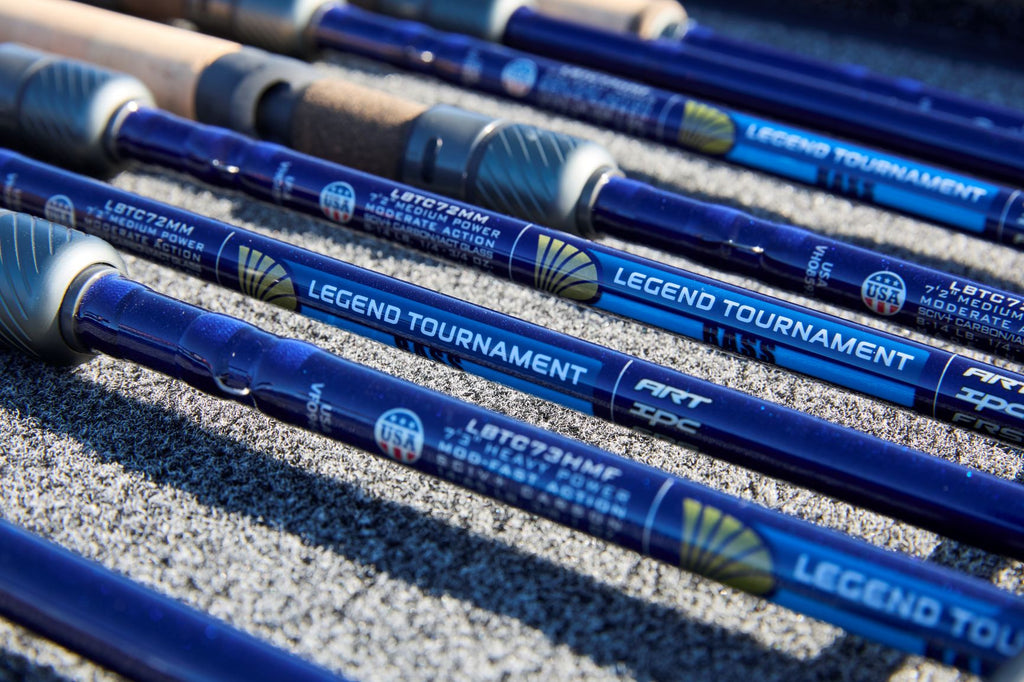More Than Reeling, More Than a Feeling
March 17, 2023

Fishing Reaction Baits is a Science for Top Bassers
PARK FALLS, Wis. (February 27, 2023) – Cast out the lure, start reeling, set the hook, fight the fish. That’s how many of us view fishing crankbaits, and the simple system works. The reality is, however, that more fish are lost on crankbaits that any other style of artificial lure. Why is that? How is it possible that a bass can come unhooked from a lure armed with six separate hook points?
Reaction baits are named as such because they trigger a predatory reaction from gamefish. Generally consisting of diving crankbaits, lipless crankbaits, bladed jigs, and some swim baits, reaction baits are typically cranked at a consistent speed and often feature relatively small treble hooks. Because these baits are moving when a bass hits them, it places special demands on the angler and the tackle. Specifically, the rod is already loaded when the fish hits – often violently – so there needs to be enough forgiveness in the tackle to keep the hooks from tearing free. This forgiveness can come from drag or from line stretch, but most significantly from the action of the rod itself. A softer rod that bends further into its mid-section is known as a moderate-action rod and is the preferred reaction-bait tool for most serious anglers, including crankbait and chatterbait savants Stephen Browning, Pat Schlapper, and Phillip Dutra.
Stephen Browning

Arkansas MLF pro, Stephen Browning, is one of bass fishing’s iron men. “The Puma” owes much of his longevity and success to his simple belief in focusing on his strengths, which more often than not means target-fishing shallow cover with a chatterbait or pounding wood with a crankbait.
“Whenever I arrive at the water I’ve got a bunch of places picked out that support my style of fishing,” Browning says. “I’ll move and adapt if I need to, but I’m never afraid to grind it out with my confidence presentations.”
Whether he’s fishing a chatterbait or a crankbait, Browning agrees that a soft rod is critical for converting bites. “A lot of times they’ll hit right at the boat and you need that soft action to allow the rod to load up,” he says. But you also need power.
“One of the big things I love to do is target cast a chatterbait around stumps, clumps of grass, and lilly pad stems…. I need a soft rod but one that’s a little stronger… I’ve got to move that fish once its hooked,” Browning says. “There’s three really unique new tri-blend cranking rods in St. Croix’s Legend Tournament Bass Series they call iACT that combine SCIV+ carbon with St. Croix’s proprietary S-glass… a 72MM, a 72HM, and a 74MHM. The new Legend Tournament Bass iACT glass 72HM (LBTC72HM) RIP-N-CHATTER is the best rod I’ve used yet that allows me to do that. It’s light and forgiving to keep bass buttoned up, with plenty of backbone to control them once they’re hooked. It’s also engineered with a smaller real seat and a great handle design that fits in my hands perfectly, and the way St. Croix utilizes the two carbon materials in conjunction with the glass gives this rod really good balance. It’s my new go to. It’s a great 3.5 or big 4.0 square bill crankbait rod as well.”
Casting accuracy is requisite to shallow-water target fishing. “Whether I’m fishing a crankbait or a chatterbait, I’ve got to put that lure right against the cover in the strike zone – whether it’s under a dock next to a specific post, along a pontoon, or against a laydown,” Browning says. “These iACT models rebound noticeably faster that a pure glass rod, which is exactly what you need for consistently accurate casts.”
Pat Schlapper

St. Croix pro, Pat Schlapper, posted three top-20 finishes in last year’s Bassmaster Elite Series. His rod arsenal included the new Legend Tournament Bass iACT models, even though he didn’t know exactly what they were at the time.
“I was involved in the whole testing process for many of the new Legend Tournament Bass models,” Schlapper says. “I picked up a big bundle of them from Teach (St. Croix Brand Manager, Ryan Teach), but I wasn’t told what they were. They were just labeled with their length, power, and action. I was using those prototypes all last season.”
The chatterbait is one of Schlapper’s confidence baits and he says he was immediately drawn to the LBTC72HM RIP-N-CHATTER rod, which is the heavy power rod in the Legend Tournament Bass iACT lineup. “I caught a lot of my fish on Chickamauga last season on that rod,” he recalls. “It’s so much thinner and lighter than my 72HM glass rods. I love the smaller diameter handles and the balance. It’s hard to find a great chatterbait rod… one that’s forgiving enough to feed them the bait with enough power to set the hook. It can’t be too soft. The new iACT carbon and glass version has the perfect balance of backbone and parabolic action. I usually like to skip a chatterbait with a carbon rod, but normally want a more parabolic moderate action. Not all HM rods are the same. This one has everything. And its lighter than any comparable rod I’ve used in the past.”
Schlapper says the new LBTC74MHM POWER GLASS CRANKER has also become his go-to for midsized cranks like DT6’s and DT10’s. “I still love my Legend Glass 74MHM but gravitate towards the Legend Tournament Bass iACT version because it’s thinner and feels even better in my hands,” says Schlapper, who says he also used the rod to add weight to his tournament bag at Lake Fork throwing a spook. “It’s really an impressive topwater rod. It’s very parabolic but has plenty of backbone and is surprisingly responsive, which makes it easy to walk a spook on braided line.”
Phillip Dutra

Professional MLF angler, Phillip Dutra, was a young man in Northern California when bionic basser, Kevin VanDam, began making bass-fishing history. “I was watching KVD on TV all the time during his mega run in those days and it occurred to me that this guy rarely lost anything he hooked. It triggered me,” Dutra says. “In most tournaments there are multiple people who had the right fish hooked to win the event, but in the end there’s only one winner. The difference is who executes and lands those fish.”
Dutra says some anglers just expect to lose more fish when throwing crankbaits. “Just a few years ago, people just accepted that they’d lose 30% of what they hooked on a crankbait,” Dutra says. “And there’s plenty of anglers who still believe that. But I studied KVD’s reaction-bait fishing. I learned that the rod, the line, the hooks, the fighting style… everything mattered. My crankbait hookup-to-landing ratios soared. Now I meticulously research every technique I fish.”
Dutra finished his rookie season in the MLF last year by cashing a check at every event but one. His secret is no secret at all. It’s printed right on his jersey as well as stickers on his boat. “SVE stands for Strategy, Versatility, Execution,” he says. “Strategy is the mental side. It’s decision making; how to meet your goals. It’s not always about the five biggest fish. It’s how you manage the conditions with which you are faced. Versatility means committing to learning all you can about every technique. It means you can quickly shift gears, adapt, and put yourself in a position to maximize opportunities.”
That leaves E for execution, which loops back to Dutra’s formative years watching and studying KVD. “I don’t care what I catch. I care what I lose,” Dutra says. “Catching one fish means nothing. You can catch one fish on any rod, reel, line, and lure. Percentages are what matters. Execution means studying every detail and making adjustments that bring more fish into the boat.”
When practicing, Dutra logs all his gear and catches on his phone. He fastidiously records what lure he’s using, what hooks are on the lure, the rod, the line, the drag setting on the reel, and how aggressively he fought the fish. “The smallest details change everything,” he says. “Any one variable can take you from 10th place to 1st, or from 3rd to 21st. There is no such thing as 100% execution in bass fishing; it’s actually a game of increments and margins. I know the difference it can make if I can improve my execution from 80% to 85% in any particular technique or presentation. But there is no accurate data until you hook a hundred bass and log how many you catch and how many you lose. Above all, you need the perfect rod for every technique.”
As you might expect, Dutra uses different moderate-action rods for different reaction-bait presentations and also varies his choices based on the conditions. “I generally prefer a full glass rod like those in St. Croix’s Legend Glass Series for chatterbaits and smaller crankbaits,” he says. “They’re really soft and give me the best landing percentages overall. If I’m fishing through grass or throwing a larger rip bait though – like a Lucky Craft 128… really any reaction bait with larger than #6 treble hooks – I’ll switch to the Legend Tournament Bass 7’2” medium-heavy power, moderate action CARBON CRANKER (LBTC72MHM). I love this rod around grass because is rips better and also has better sensitivity so I can feel if my lure is running right or fouled with a tiny piece of grass. It’s also my go-to for most square bills and medium-diving crankbaits.”
Dutra says he’s excited to start using and logging fish with the new iACT glass rods in the new Legend Tournament Bass Series. “I haven’t had the opportunity to fish any of them yet but am ordering them this week. St. Croix says they’re lighter, thinner, and more sensitive than their glass rods, but softer than their pure carbon cranking rods, which sounds like they’re really going to hit a sweet spot for me and a lot of other anglers who are particular about their reaction-bait presentations.”
Dutra offers the following advice for anglers who want to improve their execution by converting more strikes with any presentation. “There’s really no shortcuts,” he says. “You’ve got to keep track of everything you’re using and everything that happens, because you need all that data in order to understand why you’re losing fish. Crankbait fishing is a good place to start training yourself, because the rod makes such a big difference. Whether it’s glass or carbon or one of the new Legend Tournament Bass iACT rods, by all means start using a moderate action rod for your crankbait fishing if you aren’t already.”
Parting Words

Reaction baits like chatterbaits and crankbaits place special demands on tackle and anglers. If you’re consistently losing fish, one of the best things you can do is switch to a slower rod. For the past 75 years, St. Croix Rod has existed to help give all anglers the upper hand on the water, which means engineering and handcrafting premium fishing rods to support any presentation or technique. St. Croix makes moderate-action rods ideal for reaction baits in several series, including Legend Glass, Mojo Bass Glass, Mojo Bass, Victory, Bass-X, and Legend Tournament Bass. Add a dedicated cranking rod or two to your arsenal and start catching the ones that have been getting away.

